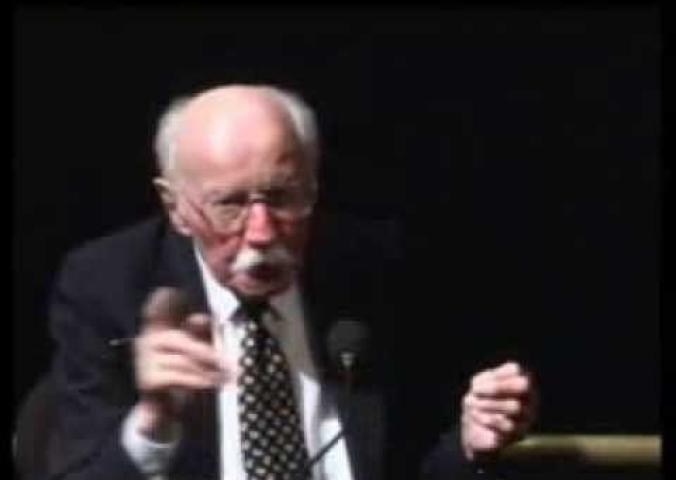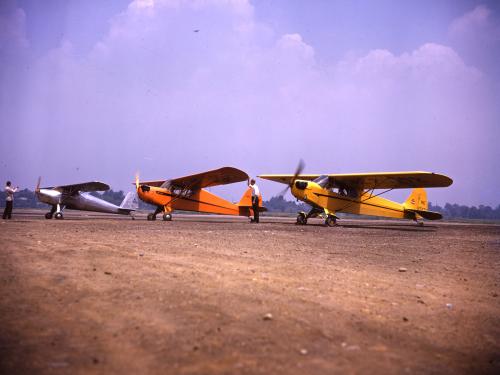North American Rockwell Shrike Commander 500S, Robert A. "Bob" Hoover
Flown by R. A. "Bob" Hoover for 20 years, N500RA is the most recognized Shrike Commander in the world. Hoover began flying in 1937, flew 58 missions in World War II, and was an outstanding military and civilian test pilot. He set altitude and speed records in several North American and Rockwell aircraft and performed at air shows in the Shrike, P-51 Mustang, T-39, Aero Commander, and Sabreliner.
The Shrike Commander, a descendent of the 1948 Aero Commander L-3805, is a twin-engine, seven-place, unpressurized business aircraft. Hoover purchased his Shrike in 1979 and, with his extraordinary test pilot and fighter pilot skills, brought this simple business aircraft design to international acclaim. In it he performed his signature deadstick (no engine) routine of loop, roll, 180-degree turn, landing, and taxi to air show center.
Flown by R.A. "Bob" Hoover for nearly 20 years, N500RA is the most recognized Shrike Commander in the world. Hoover used his extensive test pilot and fighter pilot skills to become a legendary air show pilot and brought a simple business aircraft to international attention.
The Shrike Commander is a descendant of the 1948 Aero Commander, L-3805, a light, twin-engine, six/seven-seat, high-wing aircraft built by the Aero Design and Engineering Corporation of Culver City, California. In 1952, the company in Bethany, Oklahoma, delivered the Model 520 five/seven-place, all-metal, twin-engine, light transport aircraft. The company introduced the more powerful Model 560 with two 350-hp engines in 1954, and then marketed a 290-hp, four-seat version, the 500U, in 1958. In 1960, the company changed its name to Rockwell Standard and then merged with North American in 1967. The 500U became the Shrike Commander, a twin-engine business aircraft powered by two fuel-injected 290 hp piston-turbo Lycoming engines, IO-540-E1B5, with Hartzell constant speed propellers. It was a cantilever, high-wing, four-place aircraft that could be converted to a seven-seat configuration with the addition of a rear bench seat. The aircraft was aluminum construction and a semi-monocoque design with retractable landing gear. It cruised at 203 mph, and had a range of 750 miles and a cruising ceiling of 20,000 feet. The aircraft carried a full complement of electronics for all-weather flight, optional de-icer boots, and optional cabin amenities such as curtains, fold-away desk, and storage cabinets. In 1973, the Rockwell International name appeared as a result of more mergers. Between 1968 and 1979, when production ended, Rockwell produced 316 Shrike Commanders.
Bob Hoover began flying at Nashville's Berry Field in 1937, where he taught himself basic aerobatic maneuvers. He joined the Tennessee Air National Guard and his squadron became part of the U.S. Army Air Corps in 1940. Because of his extraordinary flying skills, Hoover soon became a test pilot, charged with flying military aircraft to the edge of their performance capabilities. Eager to fly in combat in World War II, Hoover was assigned to Corsica and flew 58 missions before being shot down. He spent 15 ½ months in a German prison camp before escaping and commandeering a Focke-Wulf FW-190 for his flight to freedom. In 1947, he was the back-up pilot for Chuck Yeager, who flew the Bell X-1 beyond the speed of sound. He became a test pilot for General Motors and North American Aviation. He also demonstrated the F-86 Sabrejet and flew several bombing missions during the Korean War.
In the 1950s, Hoover began flying North American aircraft, most famously the P-51 Mustang, at military bases and then at major civilian air shows. Hoover also flew the business version of the T-39 jet, the Sabreliner, and then in 1968, he began demonstrating the Aero Commander fleet at the National Business Aircraft Maintenance Show in Reading, Pennsylvania. He also set altitude and speed records in North American and Rockwell aircraft. He began flying the Shrike Commander model in 1973.
Shrike Commander 500S, N500RA, was manufactured in 1972. President and C.E.O. of Rockwell International, Robert Anderson, first flew the aircraft, followed by several other owners, before Hoover bought it in 1979. N500RA was a production 500S business aircraft, with the exception of smoke and propeller unfeathering systems. He painted it in a distinctive white and green paint scheme, with his name on the top of each wing. Hoover's routine demonstrated the Shrike's excellent high and low-speed handling capabilities, and its one-engine and no-engine performance. But because it was a stock business aircraft that lacked highly modified engines and quick climb or turn characteristics, the Shrike Commander was a more challenging aircraft for air show flight than his P-51 fighter. In addition to sixteen-point rolls and loops, Hoover flew a precise deadstick (no-engine) maneuver with a loop, eight-point roll, a 180-degree turn to a touchdown with first one wheel and then the other wheel, landing, and taxi to air show center.
One particular maneuver demonstrated Hoover's superb pilot skills in both the Shrike and the Sabreliner, but it is only visible on film. At altitude, Hoover set a glass on top of the instrument panel and proceeded to pour iced tea into the glass from a pitcher in his right hand while using his left hand to completely roll the aircraft. Combining centrifugal force with smooth handling of the controls, he never spilled a drop of tea.
Hoover flew the aircraft at air shows in the United States and around the world until April 1994 when the FAA intervened. In a highly controversial decision, Hoover's medical certificate was revoked, causing an outcry from the aviation community. Hoover submitted to several medical examinations and flight tests, consistently proving his health qualifications and flight proficiency, before his certificate was restored to him, at age 73, in October 1995. In 2000, Hoover, citing high insurance costs, decided to retire the aircraft and offer it to the Museum.
Robert A. Hoover was a past president of the Society of Experimental Test Pilots, and is enshrined in the National Aviation Hall of Fame and the International Council of Air Shows (ICAS) Hall of Fame. Among many other honors, he is a recipient of the Distinguished Flying Cross, the Smithsonian Institution's Lindbergh Medal, and the Museun's Lifetime Achievement Award.
In April 2000, Hoover flew the Shrike to the Sun'N'Fun fly-in and for temporary display in the Sport Aviation Museum in Lakeland, FL. In the fall of 2003, Bob Hoover and Steve Clegg, his ferry pilot, flew the Shrike to the Steven F. Udvar Hazy Center in Chantilly, VA. With a total of 5,385 hours of flight time, N500RA is displayed in the Boeing Aviation Hanagar.
This object is on display in Business Aviation at the Steven F. Udvar-Hazy Center in Chantilly, VA.
Video
Length: 11.2 m (36 ft 7 in)
Height: 4.4 m (14 ft 6 in)
Weight, empty: 2,102 kg ( 4,635 lb)
Weight, gross: 3,062 kg (6,750 lb)
Top speed: 346 km/h (215 mph)
Engine: 2 Lycoming IO-540-E1B5, 290 hp
Wings - cantilever, high wing monoplane
Tail - all-metal
Landing gear - retractable tricycle
For more information, visit the Smithsonians Terms of Use.





